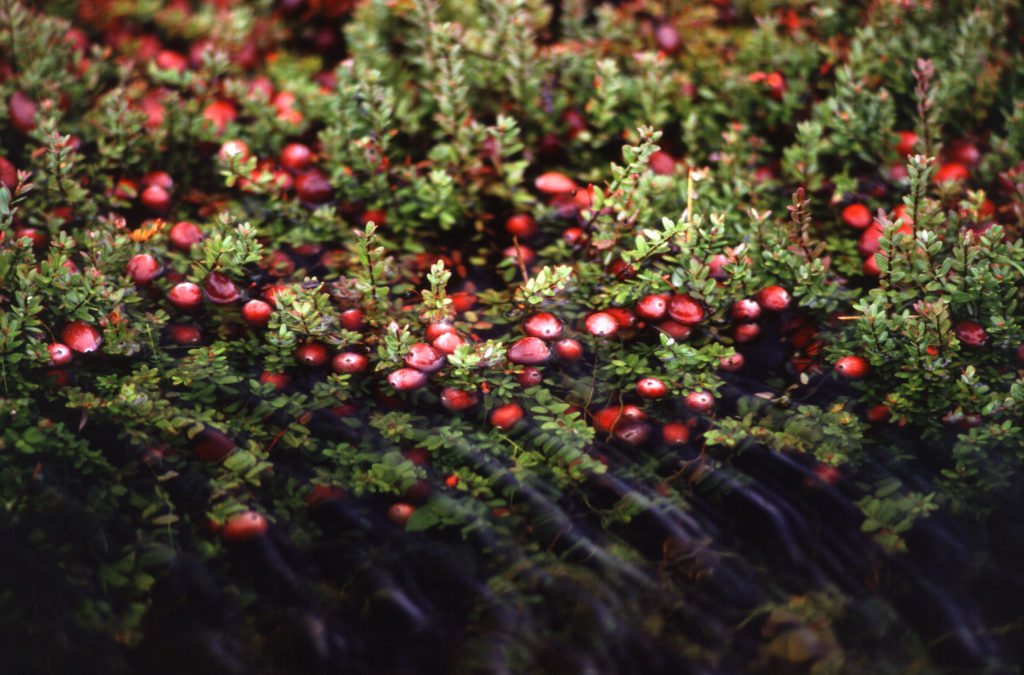
by Crystal Cockman
January 3, 2018

Growing up, around Thanksgiving each year we would break out an old-timey sausage grinder, one of those with the hand crank, and make cranberry salad. We’d gingerly assemble the pieces of the machinery together, as we had to remember from one year to the next which piece went where. I enjoyed feeding the crisp, bright red cranberries into the opening and hearing them pop and squish as they were ground up and ran through the grinder, the hand crank turned by my Grandfather. He passed away 9 years ago and the job of wielding the large metal handle was passed on to me. We’d intersperse slices of orange, peel and all, into this delightfully tart treat. The finished version had strawberry jello and pecans added, creating a variety of textures all pleasing to the pallet. We’d make enough to freeze some for Christmas and New Year’s Day. We haven’t done it in a few years, but I hope to revive the tradition.
The American cranberry (Vaccinium macrocarpon) is a low-growing evergreen shrub. The flowers are dark pink and are pollinated by bees. The fruit is a berry that is larger than the leaves of the plant. The berries are green to begin with and turn a bright red in the fall. Cranberries are a major commercial crop in certain American states and Canadian provinces.
You may have seen those Ocean Spray commercials with cranberry farmers up to their waists in water and floating cranberries. However during the growing season, which is most of the time, cranberries are grown in the dry. Commercial cranberry bogs are only flooded when the berries are ready to be harvested. The majority of berries are wet-harvested, but they can be dry-harvested as well. Dry-harvesting is more labor intensive and produces less yield, but results in less damage to the berries and they can be sold as fresh fruit. The cranberry is one of only three native North American fruits that are commercially grown in the United States (the other two are the blueberry and Concord grape). The U.S. states of Massachusetts, New Jersey, Oregon, Washington, and Wisconsin grow the majority of cranberries in the United States.
There are also wild cranberry bogs. One of the southernmost is found in Ducktown in Polk County Tennessee. It is a 120-acre site along Brush and Belcher creeks and is one of only a handful of sites in the state of Tennessee. This cranberry bog – formally designated the William L. Davenport Refuge Class II Natural-Scientific State Natural Area – is owned by the Tennessee Department of Environment and Conservation and jointly managed with the Tennessee Wildlife Resources Agency. The Nature Conservancy and East Tennessee State University also manage several cranberry bogs in Shady Valley, Tennessee. Public access to the William L. Davenport Refuge is permitted; however, the site is unmarked, and trails and a parking area have not been developed. The site is located about 1.2 miles north of the Main Street crossing in Ducktown on the west side of State Highway 68.
Native cranberry bogs are believed to be a remnant of the last ice age. Native Americans used cranberries for food and for dye. Southern Appalachian bogs can contain thick layers of cranberry, ferns, grasses and sedges, as well as layers of blueberries, alder, holly and chokeberry. Frequently the plants in these bogs get shaded out by hardwood trees and invasive species like kudzu. That’s why it’s important that these bogs are conserved and managed, by thinning and removing encroaching trees and invasive species.
A colleague of mine has been to one of these bogs in Tennessee, and she said the ground felt squishy, like peat underneath her feet. Cranberries are also sometimes called fenberries in England, because they are found in fens, a marshy habitat. If you do visit a wild cranberry bog, resist the urge to pick the berries, as they are rare and it’s important to keep them in the seedbank so the population can continue to exist and hopefully even expand. When making cranberry salad as a girl, I didn’t even know about the commercial cranberry bogs where the berries I used were grown, much less imagining about such a neat place as a wild cranberry bog, but it’s another unique natural community found in the southeast. I’m happy to know some of these unique cranberry bogs are protected, and look forward to visiting one sometime in the future.